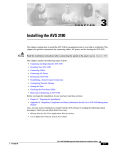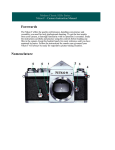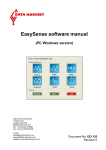Download Cisco AVS 3120 User guide
Transcript
C H A P T E R 3 Installing the AVS 3120 This chapter explains how to install the AVS 3120 in an equipment rack, or on a table or workbench. This chapter also provides instructions for connecting cables, AC power, and for booting the AVS 3120. Warning Read the installation instructions before connecting the system to the power source. Statement 1004 This chapter contains the following major sections: • Unpacking and Inspecting the AVS 3120, page 3-2 • Installing Your AVS 3120, page 3-2 • Connecting Cables, page 3-6 • Connecting AC Power, page 3-7 • Booting the AVS 3120, page 3-8 • Establishing a Serial Console Connection, page 3-9 • Configuring Network Settings, page 3-10 • Setting the Time, page 3-12 • Checking the Front Panel LEDs, page 3-13 • Removing or Replacing an AVS 3120, page 3-14 Before you begin the installation, be sure you have read the Regulatory Compliance and Safety Information for the Cisco AVS 3120 Application Velocity System document and Chapter 2, “Preparing for Installation.” Also, you may want to familiarize yourself with the AVS software by reading the following related documents, which you can obtain from Cisco.com: • Release Note for the Cisco Application Velocity System • Cisco Application Velocity System User Guide Cisco AVS 3120 Application Velocity System Hardware Installation Guide OL-11805-01 3-1 Chapter 3 Installing the AVS 3120 Unpacking and Inspecting the AVS 3120 Unpacking and Inspecting the AVS 3120 The AVS 3120 shipment contains the following items: • One RJ-45 to female 25-pin sub-d connector • One RJ-45 to female 9-pin sub-d connector • One RJ-45 console cable • Two 6-ft Ethernet cables • One rack mounting kit—two metal brackets and screws • Four rubber feet • Cisco Product Documentation CD-ROM and Warranty Package • Cisco AVS 3120 Application Velocity System Hardware Installation Guide The AVS 3120 is shipped in a protective shipping carton. It is shipped as a self-contained chassis; no components can be added or removed. Follow these steps to unpack the AVS 3120: 1. Remove the AVS 3120 accessories from the shipping carton. Save the packing materials in case you need to repack the AVS 3120 later. 2. Check the configuration of the AVS 3120 and the accessories against the items listed on the packing slip. Report any discrepancies as described in “If the Product is Damaged”. 3. Before installing the AVS 3120, review the information outlined in Chapter 2, “Preparing for Installation.” If the Product is Damaged If any portion of the unit or component is damaged in transit, forward an immediate request to the delivering carrier to perform an inspection of the product and to prepare a damage report. Save the container and all packing materials until the contents are verified. Concurrently, report the nature and extent of the damage to Customer Service. Report the problem or deficiency to Customer Service along with the model number and serial number. Upon receipt of this information, you will be provided with service instructions, or a Return Material Authorization (RMA) number and shipping information. To obtain assistance, refer to the “Obtaining Documentation” section on page xiv. Installing Your AVS 3120 Place the AVS 3120 in the desired location. You can mount it in a rack for your convenience, or place it on a solid, stable surface. If you do not plan to install the AVS 3120 in an equipment rack, proceed to the “Installing the AVS 3120 on a Workbench or Tabletop” section on page 3-5. Racks are marked in vertical increments of 1.75 inches (4.45 cm). Each increment is referred to as a rack unit (RU). A 1-RU device is 1.75 inches (4.45 cm) tall. Warning Only trained and qualified personnel should be allowed to install, replace, or service this equipment. Statement 1030 Cisco AVS 3120 Application Velocity System Hardware Installation Guide 3-2 OL-11805-01 Chapter 3 Installing the AVS 3120 Installing Your AVS 3120 Warning To prevent bodily injury when mounting or servicing this unit in a rack, you must take special precautions to ensure that the system remains stable. The following guidelines are provided to ensure your safety: • This unit should be mounted at the bottom of the rack if it is the only unit in the rack. • When mounting this unit in a partially filled rack, load the rack from the bottom to the top with the heaviest component at the bottom of the rack. • If the rack is provided with stabilizing devices, install the stabilizers before mounting or servicing the unit in the rack. Statement 1006 This section contains the following procedures: • Attaching a Two-Post Rack Bracket to the AVS 3120 • Installing the AVS 3120 on a Workbench or Tabletop Attaching a Two-Post Rack Bracket to the AVS 3120 You may install the AVS 3120 in either a four-post rack or a two-post rack by using the two-post rack brackets included in the accessory kit. Follow these steps: 1. Place the right-hand bracket on the right side of the AVS 3120, as shown in Figure 3-1. Align the bracket with the screw holes in the AVS 3120, and use two round head screws to secure the bracket. Repeat this step to attach the left-hand bracket to the AVS 3120. Note that the brackets are different. Cisco AVS 3120 Application Velocity System Hardware Installation Guide OL-11805-01 3-3 Chapter 3 Installing the AVS 3120 Installing Your AVS 3120 Figure 3-1 Cisco Attaching the Brackets to the Sides of the AVS 3120 AVS 31 20 series tion Ve lo Applica city Sy 143771 stem Note The top hole on the left bracket is a banana jack that you can use for ESD grounding purposes when you are servicing the system. You can use the two threaded holes to mount a ground lug to ground the chassis. 2. Select a location in the rack to mount the AVS 3120, and then position the AVS 3120 and brackets in the rack. 3. Align the right side bracket on the AVS 3120 to the front of the rack, and then insert and tighten the two round head retaining screws to secure the AVS 3120 to the rack, as shown in Figure 3-2. Repeat this step to secure the left side bracket to the rack. Cisco AVS 3120 Application Velocity System Hardware Installation Guide 3-4 OL-11805-01 Chapter 3 Installing the AVS 3120 Installing Your AVS 3120 Figure 3-2 Installing the AVS 3120 in a Two-Post Rack Cisco POWER STATUS AVS 312 Applicati 0 ser ies on Velocity System 143772 FLASH To remove the appliance from the rack, remove the screws that attach the appliance to the rack, and then remove the appliance. Installing the AVS 3120 on a Workbench or Tabletop When you install an AVS 3120 on a workbench or tabletop, ensure that the surface is clean and in a secure location and that you have complied with the following requirements: • The chassis should be installed off of the floor. Dust that accumulates on the floor is drawn into the interior of the chassis by the cooling fans. Excessive dust inside the AVS 3120 can cause overtemperature conditions and component failures. • There must be approximately 19 inches (48.26 cm) of clearance at the front and rear of the chassis for accessing network cables and equipment. • The AVS 3120 must receive adequate ventilation. Follow these steps to install the AVS 3120 on a workbench or tabletop: 1. Remove any debris and dust from the tabletop or workbench, as well as from the surrounding area. Ensure that your path between the AVS 3120 and its new location is unobstructed. 2. Place one rubber foot in each corner on the bottom of the AVS 3120. The rubber feet have an adhesive backing. Peel the protective tape off of the adhesive, and adhere the feet to the four round, recessed areas on the bottom of the chassis. 3. Place the chassis on the tabletop or workbench. 4. Ensure that no exhaust air from other equipment will be drawn into the chassis. Also, ensure that there is adequate clearance at the front and rear of the chassis. Cisco AVS 3120 Application Velocity System Hardware Installation Guide OL-11805-01 3-5 Chapter 3 Installing the AVS 3120 Installing Your AVS 3120 Connecting Cables Warning Do not work on the system or connect or disconnect cables during periods of lightning activity. Statement 1001 To connect network and console cables to your AVS 3120: For network connections, connect a Category 3, 4, or 5 unshielded twisted-pair (UTP) cable to the Ethernet port 1 connector on the AVS 3120 back panel (Figure 3-3). Ethernet port 1 is for management console connectivity. Note that in software version: 1. Note • 5.0, the other ports are not active. Ethernet port 1 is used for all network traffic. • 6.0 and greater, the other ports have different functions depending on how you configure the AVS software. For details on port assignments, see the Release Note for the Cisco Application Velocity System and the Cisco Application Velocity System User Guide. The 100BASE-TX/1000BASE-T Ethernet standard requires that you use standard four twisted-pair Category 5e cable at lengths up to 328.08 ft. (100 m). Figure 3-3 Ethernet Port 1 1 MGMT USB1 LNK SPD 2 LNK SPD 3 LNK SPD 4 143773 USB2 LNK SPD 1 2. Connect the other end of the network cables to a hub or switch in your network. 3. Connect the console cable as shown in Figure 3-4 so that you have either a DB-9 or DB-25 connector on one end, as required by the serial port for your console, and the other end is the RJ-45 connector. Connect the RJ-45 connector to the console port, and connect the other end to the DB-9 or DB-25 connector on a console or a communications server. Note Use the console port to connect to a computer, console, or communications server to enter configuration commands. Locate the serial cable from the accessory kit. The serial cable assembly consists of a 180/rollover cable with RJ-45 connectors, a DB-9 connector adapter PN 74-0495-01, and a DB-25 connector adapter PN 29-0810-01. Cisco AVS 3120 Application Velocity System Hardware Installation Guide 3-6 OL-11805-01 Chapter 3 Installing the AVS 3120 Connecting AC Power Figure 3-4 Console Connection CONSOLE FLASH SH S FL A ST AT U PO W ER AUX Console port (RJ-45) Computer serial port DB-9 or DB-25 114418 RJ-45 to DB-9 or DB-25 serial cable (null-modem) Connecting AC Power Warning This equipment must be grounded. Never defeat the ground conductor or operate the equipment in the absence of a suitably installed ground conductor. Contact the appropriate electrical inspection authority or an electrician if you are uncertain that suitable grounding is available. Statement 1024 To connect AC power to your AVS 3120, follow these steps: 1. Ensure that you have reviewed the safety information outlined in Chapter 2, “Preparing for Installation.” 2. Attach the grounding lug to the side of the appliance. Cisco AVS 31 20 series tion Ve loc Applica ity Syste 143780 m Note Use 8-32 screws to connect a copper standard barrel grounding lug to the holes. The appliance requires a lug where the distance between the center of each hole is 0.56 inches (1.42 cm). The ground lug must be NRTL listed or recognized. In addition, the copper conductor (wires) must be used and the copper conductor must comply with the NEC code for ampacity. A lug is not supplied with the appliance. 3. Plug the AC power cord into the power cord receptacle at the rear of the AVS 3120 (see Figure 1-2). 4. Connect the other end of the power cord to a power source. Cisco AVS 3120 Application Velocity System Hardware Installation Guide OL-11805-01 3-7 Chapter 3 Installing the AVS 3120 Booting the AVS 3120 5. Power up all externally-connected devices. 6. Switch on the power switch on the rear of the AVS 3120. Booting the AVS 3120 When you power up the AVS 3120, the boot process does the following: Note • Performs hardware initialization and power-on self tests • Initializes the BIOS • Loads the rommon • Displays the boot menu (only if a console is connected, see the subsection below) • Boots the AVS 3120 image (kernel and software) During power-up, the green status LED on the front of the AVS 3120 blinks. At this point, you are ready to configure and use the AVS 3120. Refer to following sections for information on establishing a console connection and configuring the network settings. Additionally, refer to the Cisco Application Velocity System User Guide for details about configuring and administering the AVS 3120 device. Booting with a Console Connected If you boot the device while a console is connected to the serial port (see the next section), a boot menu is displayed on the console, like this: Launching BootLoader... Boot configuration file contains 2 entries. GNU GRUB version 1.0(11)0 (631K lower / 4062208K upper memory) ------------------------------------------------------------------0: Cisco AVS Runtime Image 1: Cisco AVS Maintenance Image ------------------------------------------------------------------Use the ^ and v keys to select which entry is highlighted. Press enter to boot the selected OS or 'p' to enter a password to unlock the next set of features. Highlighted entry is 0: Normally, you do not need to interact with this menu. After ten seconds, the device will automatically boot into the standard Cisco AVS Runtime Image (choice 0 on the menu, and the default). You can press Enter to avoid this delay and choose the default. To select a different boot image, use the up or down arrow keys to select it, and press Enter to continue with the boot process. Note The Cisco AVS Maintenance Image is used only for device maintenance or upgrade purposes and should not be used for normal operation. Cisco AVS 3120 Application Velocity System Hardware Installation Guide 3-8 OL-11805-01 Chapter 3 Installing the AVS 3120 Establishing a Serial Console Connection Establishing a Serial Console Connection Before you can configure the AVS 3120 by using the command line interface (CLI), you must establish a serial console connection to it. This requires a PC, a DB-9 to RJ-45 adapter (provided), an RJ-45 180/rollover cable (provided), and terminal emulation communication software (Hyper Terminal or equivalent). You may also use a serial concentrator connection, if desired. To establish a serial console connection, follow these steps: 1. Connect a console to the serial console port on the rear panel: a. Attach a DB-9 or DB-25 to RJ-45 adapter to the serial port of the console computer. b. Use the RJ-45 180/rollover cable to connect the console to the console serial port on the AVS 3120. For the location of the serial port, see Figure 3-4. 2. If you have not already done so, power up the AVS 3120 as described in the “Booting the AVS 3120” section on page 3-8. 3. Open your terminal emulation application on your PC to access the AVS 3120 CLI. The following procedure uses HyperTerminal for Windows: a. Launch HyperTerminal. The Connection Description window appears. b. Enter a name for your session in the Name field. c. Click OK. The Connect To window appears. d. From the drop-down list, choose the COM port to which the device is connected. e. Click OK. The Port Properties window appears. f. Set the port properties: Baud Rate = 9600 Data Bits = 8 Flow Control = none Parity = none Stop Bits = 1 g. Click OK to connect. h. Press Enter to display the CLI prompt. 4. After you create a session, choose Save As from the File menu to save the connection description. Saving the connection description has the following two advantages: – The next time you launch HyperTerminal, the session is listed as an option under Start > Programs > Accessories > HyperTerminal > Name_of_session. This option lets you reach the CLI prompt directly without repeating the configuration steps. – You can connect your cable to a different device without configuring a new HyperTerminal session. If you use this option, ensure that you connect to the same port on the new device as was configured in the saved HyperTerminal session. Otherwise, a blank screen appears without a prompt. For information about using the CLI to configure the AVS 3120, refer to the following section, “Configuring Network Settings” and the Cisco Application Velocity System User Guide. Cisco AVS 3120 Application Velocity System Hardware Installation Guide OL-11805-01 3-9 Chapter 3 Installing the AVS 3120 Configuring Network Settings Configuring Network Settings After you have installed the AVS 3120, you must configure the basic network settings by using the set command in the CLI from a console connection. After the basic network settings have been configured, you can perform additional CLI configuration through the network by using an SSH connection. Additionally, you can configure application acceleration and other features by using the Management Console GUI in a Web browser. For details about using the CLI and Management Console, refer to the Cisco Application Velocity System User Guide. To configure the basic network settings, follow these steps: Step 1 Note Log in to the AVS 3120 from a console connected to the serial port. The default username is fgn, and the password is fineground. After you log in, the velocity> prompt appears. Step 2 Enable writing configuration settings with the enable command: velocity>enable Step 3 Configure the network interface with the set interface command: velocity>set interface ip ip netmask mask default-gateway gw autoneg on where: ip is the device interface IP address, such as 10.210.10.45 mask gw is the device interface network mask, such as 255.255.255.0 is the gateway address, such as 10.210.2.1 can be set to on or off, for speed autonegotiation (if off, you must set the speed and duplex settings manually by using the speed and duplex options) autoneg You can view the interface settings by using the show interface command: velocity>show interface PHYSICAL INTERFACE eth1 MAC ADDRESS: 00.0f.f7.75.75.73 Auto Negotiation: on Duplex: full Speed: 100 RX: PKTS=1206954 BYTES=114173340 TX: PKTS=428072 BYTES=53566339 MTU: 1500 INTERFACE NUMBERS IP/NETMASK: 10.210.2.45/255.255.255.0 DEFAULT GATEWAY: 10.210.2.1 Step 4 ERRORS=0 ERRORS=0 Configure the DNS server addresses with the set dns command: velocity>set dns primary ip1 secondary ip2 where: ip1 is the primary DNS server IP address or name, such as 10.68.226.120 ip2 is the secondary DNS server IP address name, such as 10.68.226.121 Cisco AVS 3120 Application Velocity System Hardware Installation Guide 3-10 OL-11805-01 Chapter 3 Installing the AVS 3120 Configuring Network Settings You can view the DNS settings by using the show dns command: velocity>show dns PRIMARY NAMESERVER 10.68.226.120 SECONDARY NAMESERVER 10.68.226.121 Step 5 Configure the local time zone with the set date tz command: velocity>set date tz timezone where: is the local city/time zone name, such as America/New_York. To see a list of available city/time zone names, use the command show timezone all. The default time zone is America/Tijuana. timezone You can view the current time zone setting by using the show timezone current command: velocity>show timezone current America/Tijuana Step 6 Configure the initial date and time setting. You can do this automatically by synchronizing to a network time protocol (NTP) server, or manually by using the set date time command. To use an NTP server, use the set ntp command, as follows: velocity>set ntp start ip where: start ip can be start, to start using NTP, or stop, to stop using NTP is the NTP server IP address or fully qualified domain name, such as 10.68.226.100 or time.nst.gov You can view the NTP settings by using the show ntp command: velocity>show ntp STATUS: RUNNING NTP SERVER: time.nist.gov If you would rather manually set the time, use the following command: velocity>set date time MM:DD:hh:mm:YYYY where MM:DD:hh:mm:YYYY is month:day:hour:minute:year You can view the time and date by using the show date command: velocity>show date Wed Dec 7 19:10:04 2005 TimeZone=America/Tijuana You must set the accurate date and time for the appliance to function properly. Note Step 7 Configure the system host name with the set hostname command: velocity>set hostname name where: name is the system host name, such as velocity2 You can view the host name setting by using the show hostname command: velocity>show hostname velocity Cisco AVS 3120 Application Velocity System Hardware Installation Guide OL-11805-01 3-11 Chapter 3 Installing the AVS 3120 Setting the Time Step 8 We also recommend that you change the account password from its default. To do this, use the edit admin command: velocity>edit admin current-name fgn new-password password where: password is the new password for the fgn account. For more details about using the CLI and the Management Console, refer to the Cisco Application Velocity System User Guide. Setting the Time Many features of AVS depend on having the clocks synchronized among all of the deployed AVS devices and the origin servers. It is important to synchronize all clocks whenever a new device is deployed. Here is a summary of the ways to set the clock on an AVS device: Note • Use the set date command to set the date, time, and local time zone. • Use the set ntp command to configure the AVS device to get its time from an NTP time synchronization source. The NTP source should be the same for all deployed AVS devices and origin servers. We recommend that you use an NTP time synchronization source. For information on using the CLI to configure the AVS 3120, refer to the Cisco Application Velocity System User Guide. For an example of using the set ntp and set date commands, refer to the previous section, Configuring Network Settings. Cisco AVS 3120 Application Velocity System Hardware Installation Guide 3-12 OL-11805-01 Chapter 3 Installing the AVS 3120 Checking the Front Panel LEDs Checking the Front Panel LEDs When the AVS 3120 is up and operational, observe the front panel LEDs to monitor the AVS 3120 operating status. Figure 3-5 shows the location of front panel LEDs, and Table 3-1 describes their function. Front Panel LEDs POWER STATUS 1 Table 3-1 1 2 3 FLASH 2 143770 Figure 3-5 3 Front Panel LED Indicators Indicator Color State Indicates Power Green On The AVS 3120 is on Off The AVS 3120 is off On Normal operation, system has passed power-up diagnostics Blinking Power-up diagnostics are running or the system is booting Amber On Power-up diagnostics have failed Green Blinking The compact flash device is being accessed Off The compact flash device is not in use Status Compact flash device Green Cisco AVS 3120 Application Velocity System Hardware Installation Guide OL-11805-01 3-13 Chapter 3 Installing the AVS 3120 Removing or Replacing an AVS 3120 Removing or Replacing an AVS 3120 Warning Before working on a system that has an on/off switch, turn OFF the power and unplug the power cord. Statement 1 Warning Ultimate disposal of this product should be handled according to all national laws and regulations. Statement 1040 To physically remove an AVS 3120 from your network follow these steps: 1. Login to the shell as the root user and execute the poweroff command. To do this: a. Access the CLI and open the shell by using the sysopen command: velocity>sysopen b. Change to the root user using the su command with the dash option: bash-2.05b$ su - root c. Enter the root password (the default is FineGr0und5!): password: d. Execute the poweroff command: -sh-2.05b# /sbin/poweroff 2. Power down the AVS 3120 by turning off the power switch on the rear panel of the AVS 3120. 3. Disconnect the power cords and network cables. 4. Physically remove the chassis from the rack. To physically replace an AVS 3120, install the new AVS 3120 and configure it using the same configuration parameters (such as the IP address) that you used for the removed AVS 3120. Refer to the Cisco Application Velocity System User Guide for configuration details. Cisco AVS 3120 Application Velocity System Hardware Installation Guide 3-14 OL-11805-01























